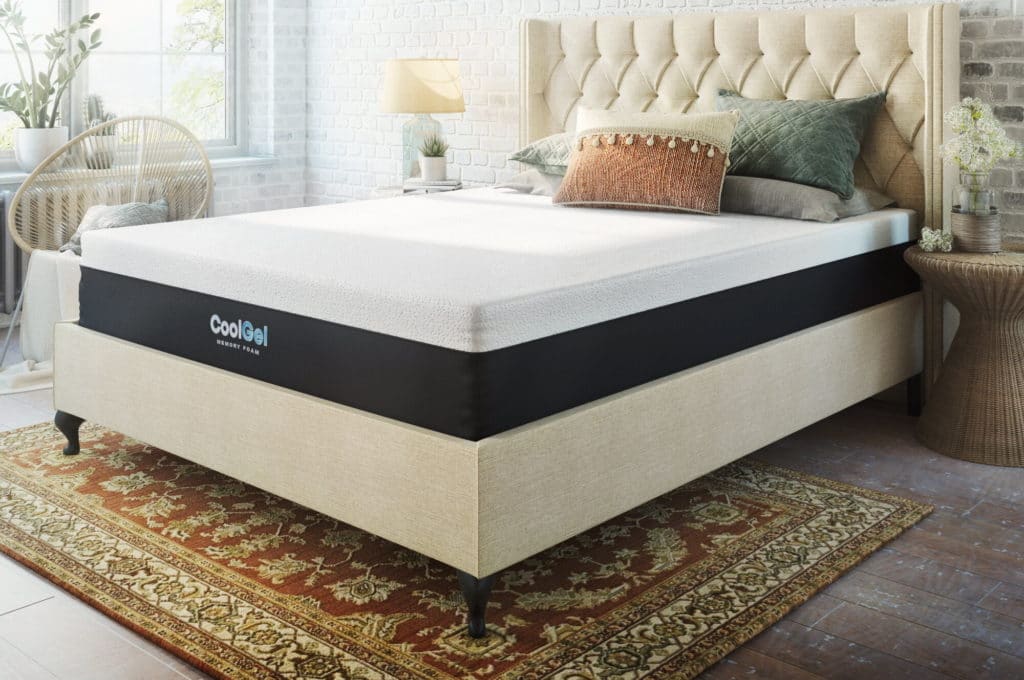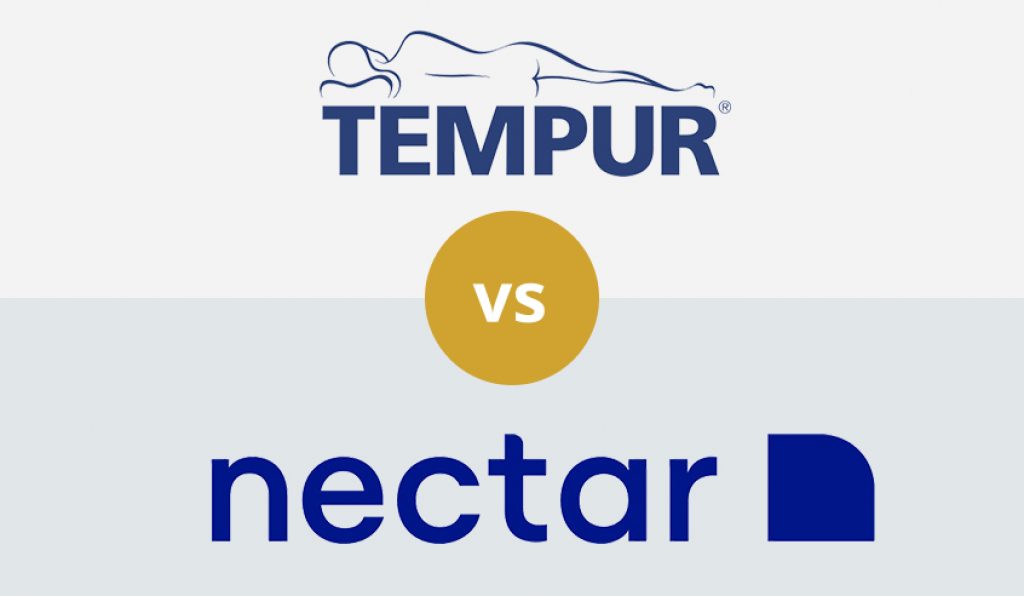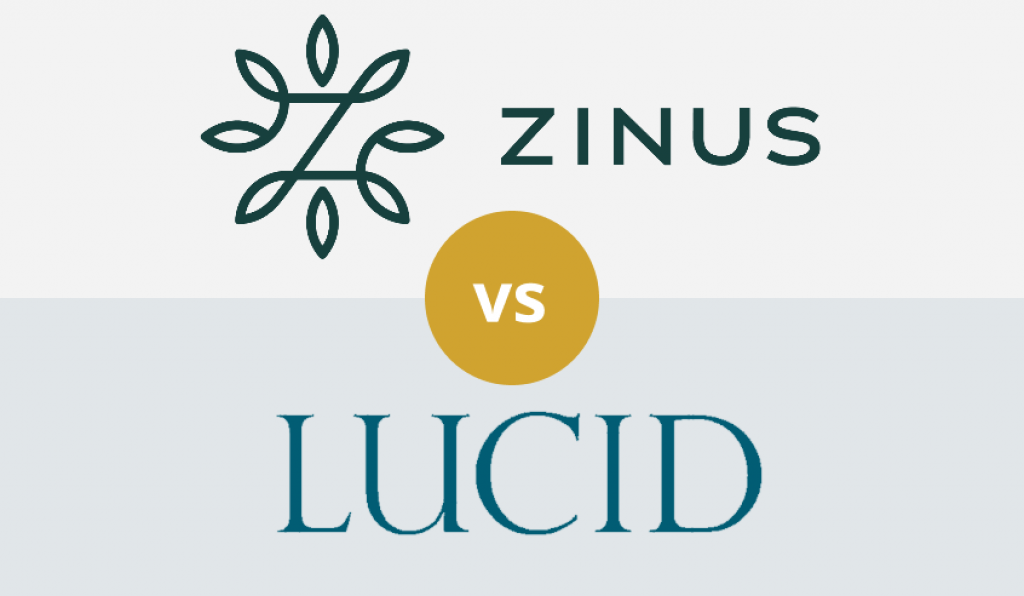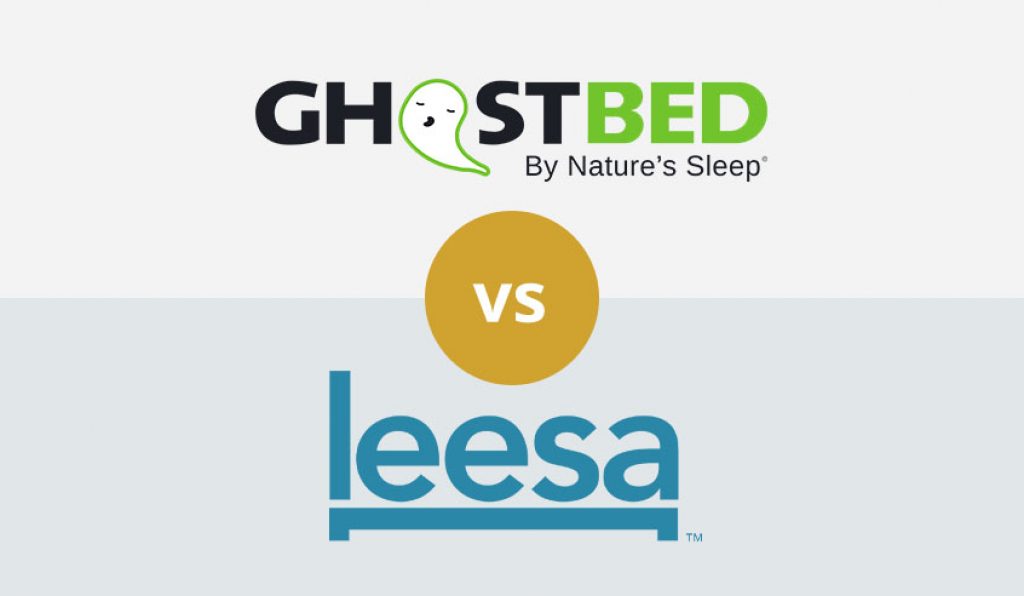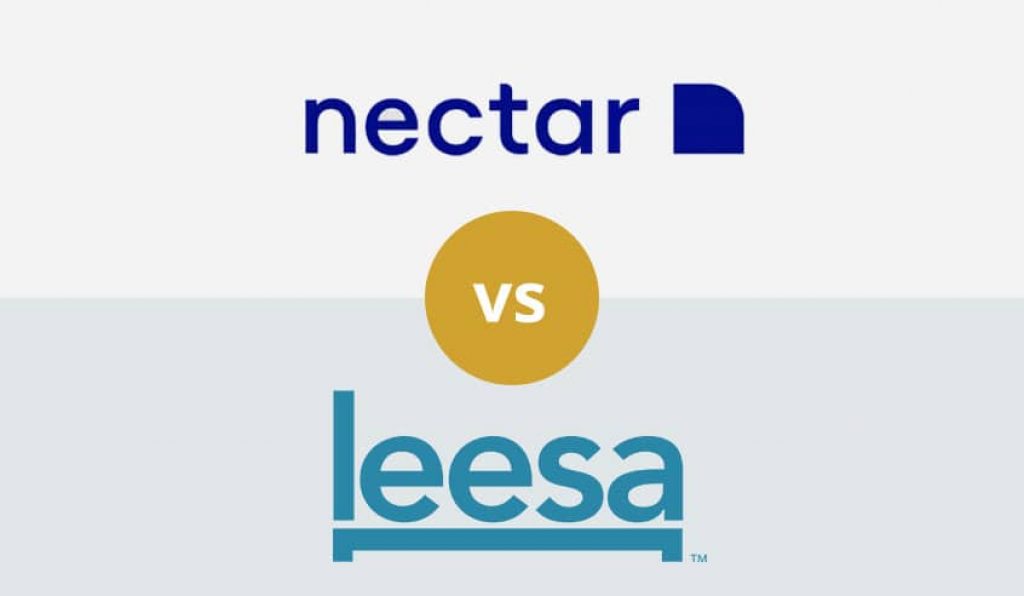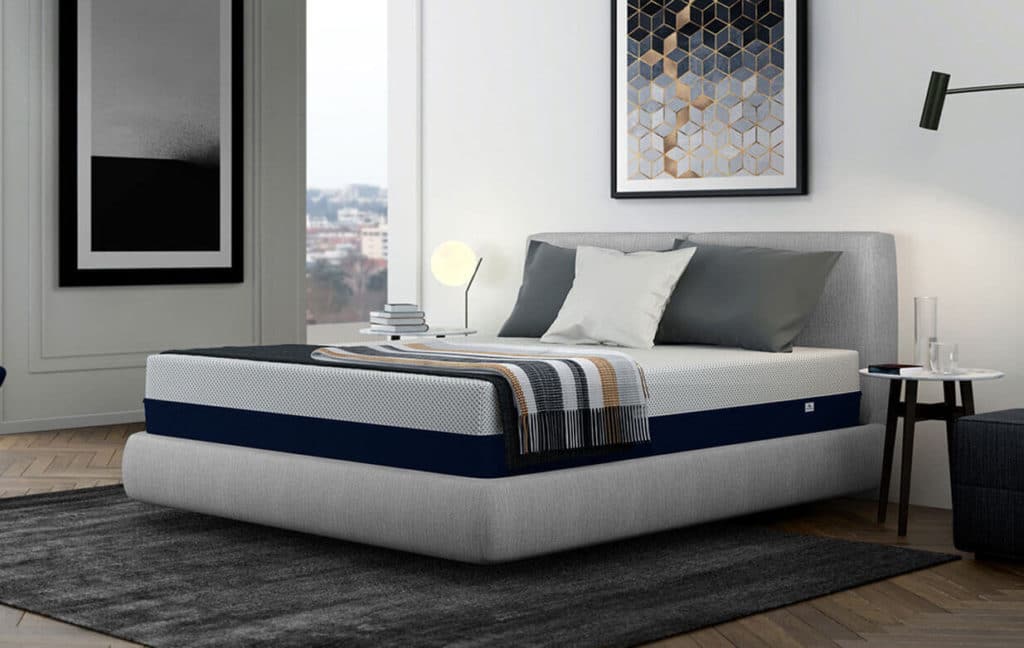

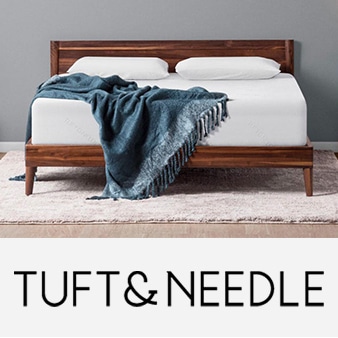
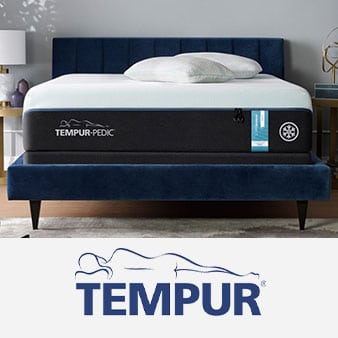
Choosing the right mattress is one of the most important parts of getting a good night’s sleep. But it can be hard to decide which of the hundreds of popular mattresses on the market is right for your comfort and sleep style. Today, we’ll compare the Tuft & Needle vs Tempur-Pedic Tempur-Adapt mattresses to see how they stack up in terms of comfort, construction, features, and more. Both mattresses are made completely of foam and rated as medium-firm beds, but there are important differences in what types of foam the mattresses use, how they keep your temperature consistent, and the style of support they offer. In addition, it’s important to note right off the bat that the Tempur-Pedic mattress line is significantly more expensive than the Tuft & Needle mattress – so we’ll specifically look at whether the added features of the Tempur-Pedic Tempur-Adapt make the additional cost worthwhile.
Both the Tuft & Needle and Tempur-Pedic Tempur-Adapt mattresses are constructed completely from foam and described as medium-firm mattresses. The mattresses compete with 3-month sleep trials so that you can ensure that you love the mattress before committing, and both come with a 10-year warranties to ensure that your bed is built to last.
That said, there are important differences between the two mattresses when it comes to construction and cost.
The Tuft & Needle mattress is a budget-friendly mattress designed with a wide variety of sleepers in mind. The bed is built with 10 inches of proprietary adaptive foam, which doesn’t allow your body to sink into the mattress or trap heat around you throughout the night. That makes the Tuft & Needle mattress ideal for back and stomach sleepers who need a firmer surface.
The Tempur-Pedic mattress is similarly designed to cater to a wide variety of sleepers. But thanks to its memory foam construction and slightly softer feel, side sleepers may find this mattress to be more comfortable overall. The memory foam construction is also worth noting because it dramatically changes the feeling of this mattress compared to the Tuft & Needle – you will experience a feeling of slowly sinking into the mattress as you settle into it. Importantly, the Tempur-Pedic Tempur-Adapt is not a budget-friendly mattress. It costs over $2,000 for a queen-sized mattress, approximately four times the price tag of the Tuft & Needle mattress.
| Tempur-Pedic | |
|
|
| VIEW ON AMAZON | VIEW ON AMAZON |
| Tuft & Needle | Tempur-Pedic | |
| Type | Foam | Foam |
| Firmness | Medium firm (6.5) | Medium (5) |
| Thickness | 10″ | 11″ |
| Weight | 71 lbs | 79 lbs |
| Sleep trial | 100 nights | 90 nights |
| Warranty | 10 years | 10 years |
| Price | $595 (Queen) | $2,099 (Queen) |
| Certification | Greenguard Gold Standard 100 by OEKO-TEX CertiPUR-US |
CertiPUR-US |
| Tuft & Needle | Tempur-Pedic | |
| Support core | 7″ 1.8 PCF HD polyfoam | Polyfoam (Solid) |
| Comfort layers | 3″ 2.8 PCF polyfoam | Memory foam |
| Cover | Micro polyamide and polyester | SmartClimate dual-layer removable cover |
The heart of where the Tuft & Needle and TempurPedic mattresses differ is in the construction of their foam layers. The Tuft & Needle mattress features a relatively simple construction, with a 7-inch layer of 1.8 PCF high-density adaptive foam and a 3-inch layer of softer adaptive foam. This adaptive foam is infused with graphite to increase its ability to conduct heat away from your body so you don’t heat up throughout the night. In addition, it’s important to note that the adaptive foam doesn’t allow you to sink into the bed like memory foam.
The support layer of the Tempur-Pedic mattress also uses high-density polyfoam to give a medium-firm base to the mattress. But the real innovation of the Tempur-Pedic mattress is the TEMPUR-ES memory foam material used in the comfort layer. This proprietary foam material is designed to conform quickly to your body when you lay down in the bed, essentially eliminating sleep-interrupting pressure points for back and side sleepers. Importantly, the foam is designed to spring back every morning for at least the 10-year lifespan of the mattress – and users found that the foam is as durable as Tempur-Pedic advertises.
Keep in mind that memory foam has a reputation for allowing heat to build up throughout the night, particularly when compared to something like Tuft & Needle’s adaptive foam. To combat this, Tempur-Pedic provides a dual-layer cool-to-touch knitted cover over their mattress. However, many users felt that the mattress still holds quite a bit of heat.
At the end of the day, choosing the right mattress for you comes down to what you feel most comfortable sleeping on. Both the Tuft & Needle and Tempur-Pedic mattresses offer comfort, but they cater to slightly different sleeping preferences. On the whole, the Tuft & Needle mattress is more firm and provides better heat transfer away from your body, while the Tempur-Pedic mattress is softer and conforms to your body to eliminate pressure points. Here, we’ll take a closer look at how these two mattresses differ in several important comfort categories.
Although both the Tuft & Needle and Tempur-Pedic Tempur-Adapt mattresses are described as medium-firm, they differ quite a bit in the level of firmness and support they provide thanks to the difference in the foam materials they use.
The Tuft & Needle mattress uses three inches of adaptive foam, which is relatively firm and does not conform to your body. That means that the Tuft & Needle leaves you feeling as if you are laying on top of the bed rather than in it, which can appeal to many back and stomach sleepers. The Tempur-Pedic mattress, on the other hand, uses a memory foam comfort layer that conforms to your body as you lay in the bed. For many people, this evokes a feeling of sinking into the bed and ultimately resting inside the bed rather than on top of it. This softer feel can appeal to people who suffer from pressure points in their current bed, such as side sleepers and some back sleepers.
The biggest setback that the Tempur-Pedic mattress faces is controlling temperature throughout the night. Memory foam is notorious for being hot since your body is somewhat surrounded by the heat-trapping foam once it conforms to your body. Tempur-Pedic partially alleviates this temperature control problem by adding a cool-to-touch knitted cover to their mattress, but many users find that the mattress remains significantly warmer than non-memory foam mattresses.
The Tuft & Needle mattress, on the other hand, is relatively cool thanks to the graphite infused into the adaptive foam. This allows the foam to more efficiently transfer heat away from your body so that it doesn’t build up throughout the night. In addition, the firmer nature of the Tuft & Needle mattress means that your body won’t be surrounded by foam during the night, which largely mitigates the problem of heat build-up.
A restless partner can be a hard-to-fix sleep killer. But if your mattress limits motion transfer across the bed, you may not even notice when your partner is tossing and turning next to you.
The Tempur-Pedic mattress is the clear winner when it comes to reducing motion transfer. The memory foam comfort layer does an excellent job at dampening vibrations. Plus, after the mattress has conformed around your body, you are essentially cocooned in the motion-dampening foam.
That’s not to say that the Tuft & Needle mattress propagates motion dramatically, but it does allow some vibration to make its way across the bed. While the adaptive foam is significantly more vibration dampening than any spring mattress, it is firm enough that you will be able to feel your partner rolling around during the night or getting out of bed.
The Tuft & Needle mattress is significantly more responsive than the Tempur-Pedic mattress thanks to the firmness of the foam. When you jump into the bed, it won’t compress much beneath you, and the foam will provide immediate support as you move around.
In contrast, the Tempur-Pedic mattress responds slowly to movements. Once you lie down in the bed, it will take a few minutes for the memory foam to fully conform to your body. If you move, the foam will then take another few minutes to spring back to its original shape. Because of this, the bed can feel as if it is constantly shifting beneath you if you roll around before falling asleep.
One of the most incredible things about the Tempur-Pedic mattress, especially compared to other memory foam mattresses, is its resilience. The memory foam returns to its original shape every morning after you get out of bed, and users found that this is true for the entire 10-year lifespan of the bed if you simply rotate the mattress twice per year as recommended. The Tuft & Needle mattress is also extremely durable, although this is less remarkable given that the foam does not compress to nearly the same degree as for the Tempur-Pedic mattress.
Neither the Tempur-Pedic nor Tuft & Needle mattresses are particularly bouncy compared to spring or hybrid mattresses, but the Tuft & Needle mattress does offer slightly more bounce between the two. This is again thanks to the lack of memory foam in the Tuft & Needle mattress – the adaptive foam is supportive enough that you can get some springiness out of it when you fall into the bed. The memory foam in the Tempur-Pedic mattress will hardly bounce at all, instead collapsing below you and then sinking further down when you first fall into the bed.
Both the Tempur-Pedic and Tuft & Needle mattresses provide surprisingly good support at the edge of the bed, whether you’re sleeping on the edge or simply sitting on the bed. The Tuft & Needle wins in this category only because the memory foam in the Tempur-Pedic mattress will slowly compress beneath you, forcing you to adjust your position as the exact location and conformation of the mattress edge changes.
The Tuft & Needle and Tempur-Pedic mattresses both arrive in a compressed form within a box and take some time to fully inflate once you lay them out on the floor. For both mattresses, the manufacturers recommend waiting 24–72 hours for full inflation – but users report that either mattress is typically ready to sleep on by the evening of the day it arrives. Users also note that while the mattresses do have a slight chemical odor when they first arrive, this is hardly noticeable and goes away entirely by the second night of sleep.
| SLEEP POSITION | Light sleepers(less than 130 lbs) | Average sleepers(130 lbs to 230 lbs) | Heavy sleepers(greater than 230 lbs) |
| Tuft & Needle | |||
| Side | 6 | 8 | 7 |
| Back | 9 | 8 | 8 |
| Stomach | 6 | 7 | 7 |
| Tempur-Pedic | |||
| Side | 8 | 9 | 8 |
| Back | 9 | 10 | 8 |
| Stomach | 8 | 7 | 7* |
* Out of 10
While both mattresses are described as being medium-firm, the difference between the softness of the memory foam in the Tempur-Pedic mattress and the support of the Tuft & Needle mattress makes them ideally suited for different styles of sleepers. The conforming nature of the Tempur-Pedic mattress eliminates pressure points, making it ideal for most side sleepers and back sleepers who have had issues with spinal pain and alignment. In addition, the cushioning feeling of the memory foam makes the Tempur-Pedic a favorite among heavier sleepers who otherwise face pressure from the support layer in the Tuft & Needle and other mattresses.
The Tuft & Needle mattress is more firm, making it a better choice for sleepers who have not had issues with pressure points and prefer the feeling of lying on top of the mattress rather than sinking into it. In general, this means that back and stomach sleepers, rather than side sleepers, benefit most from the Tuft & Needle mattress.
| SIZE | Tuft & Needle | Tempur-Pedic |
| Twin | $350 | $1,599 |
| Twin XL | $395 | $1,599 |
| Full | $495 | $1,914 |
| Queen | $595 | $2,099 |
| King | $750 | $2,792 |
| California King | $750 | $2,799 |
| Split California King | N/A | $1,699 |
| Sleep trial | Warranty and refund | Delivery | |
| Tuft & Needle | 100 nights | 10-year warrantyFull refund | Within the U.S. |
| Tempur-Pedic | 90 nights | 10-year warranty Full refund minus shipping charges |
Within the U.S. |
Both the Tuft & Needle and Tempur-Pedic mattresses come with very comprehensive 10-year warranties. These warranties cover anything outside normal wear and tear on the mattress, including the foam forming divots over time – which is one of the most prominent concerns with any foam mattress. Importantly, users note that the memory foam in the Tempur-Pedic mattress effectively keeps its form and bounces back for the entire 10-year or longer lifespan of the bed.
One thing to watch out for with the Tempur-Pedic warranty is that there is some hidden risk. Damage to the cover during shipping, for instance, is not covered by Tempur-Pedic. In addition, you are responsible for the shipping charges – which can be substantial – in the case of a warranty claim.
Both mattresses come with sleep trials – 90 nights for the Tempur-Pedic mattress and 100 nights for the Tuft & Needle mattress. If you’re not fully satisfied by the mattress after this time, both companies will work with you to either pick up the mattress from your home or have you drop it off at a local store.
Pros
Cons
Pros
Cons
Both the Tuft & Needle and Tempur-Pedic mattresses have a lot to offer for different styles of sleepers. The relatively firm adaptive foam of the Tuft & Needle mattress makes it an ideal choice for back and stomach sleepers who don’t like the feeling of sinking into a memory foam bed. Plus, the graphite infusion in Tuft & Needle’s adaptive foam ensures that you won’t face problems with temperature control during the night.
On the other hand, the Tempur-Pedic mattress is hard to beat for side sleepers and heavyset sleepers who face issues with pressure points. The proprietary memory foam is arguably the best available and springs back to form for at least the 10-year warranty period of the mattress. However, the Tempur-Pedic mattress is extremely expensive compared to the Tuft & Needle mattress and has issues with heat building up throughout the night, even in spite of the included cool-to-touch cover.
With all that in mind, the Tuft & Needle is the more cost-effective choice for sleepers who feel comfortable on the firmer foam material. Plus, in addition to saving money, you don’t have to worry quite as much about hot summer nights when sleeping on the Tuft & Needle mattress.
